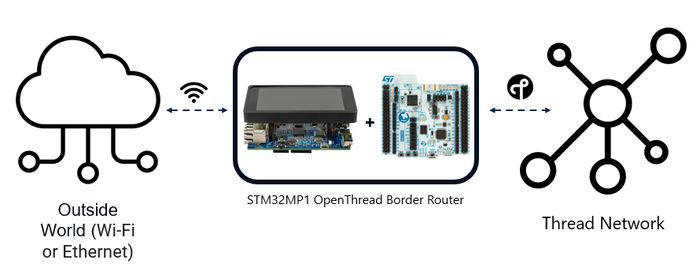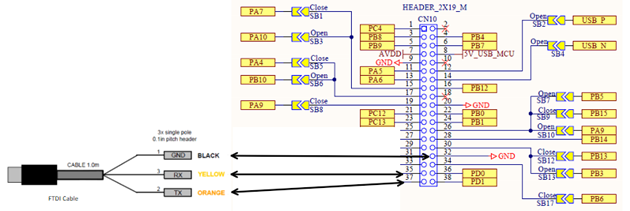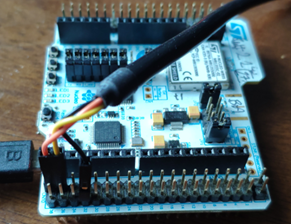Registered User m (Escoda Michael moved page Connectivity:STM32MP1 OpenThread border router to Connectivity:STM32 OpenThread border router without leaving a redirect) |
Registered User mNo edit summary Tag: 2017 source edit |
||
| Line 1: | Line 1: | ||
{{DISPLAYTITLE:STM32MP1 OpenThread border router}} | {{DISPLAYTITLE:STM32MP1 OpenThread border router}} | ||
<!-- {{DISPLAYTITLE:STM32 OpenThread border routers}} --> | <!-- {{DISPLAYTITLE:STM32 OpenThread border routers}} --> | ||
== | ==Introduction== | ||
The OpenThread Border Router (OTBR) is crucial in Matter to enable the communication between IP-based networks. It acts as a bridge between the Thread network and the outside world.</br> | The OpenThread Border Router (OTBR) is crucial in Matter to enable the communication between IP-based networks. It acts as a bridge between the Thread network and the outside world.</br> | ||
<!-- Each node forming the '''802.15.4''' network of the Thread implementation can act with the following roles: leader, router, end device or sleepy end device (SED). A special role named '''Border Router''' allows the Thread nodes to access the outside world through an end-to-end '''IPv6''' connection. A Thread Border Router (ie. Thread BR) connects a Thread network to other IP-based networks, such as Wi-Fi or Ethernet. It is basically a bridge between Thread network and a Wi-Fi or Ethernet interface.<br> | <!-- Each node forming the '''802.15.4''' network of the Thread implementation can act with the following roles: leader, router, end device or sleepy end device (SED). A special role named '''Border Router''' allows the Thread nodes to access the outside world through an end-to-end '''IPv6''' connection. A Thread Border Router (ie. Thread BR) connects a Thread network to other IP-based networks, such as Wi-Fi or Ethernet. It is basically a bridge between Thread network and a Wi-Fi or Ethernet interface.<br> | ||
| Line 18: | Line 18: | ||
* External Thread commissioning (for example, a mobile phone) to authenticate and join a Thread device to a Thread network. | * External Thread commissioning (for example, a mobile phone) to authenticate and join a Thread device to a Thread network. | ||
== | ==STM32MP1 OpenThread border router== | ||
The STM32MP1 OTBR works with the NUCLEO-WB55RG radio coprocessor (RCP), which is connected to the STM32MP157F-DK2 Discovery kit ([https://wiki.st.com/stm32mpu/wiki/Category:STM32MP15_Discovery_kits wiki for STM32MP15 Discovery kits]) or STM32MP135F-DK Discovery kit ([https://wiki.st.com/stm32mpu/wiki/Category:STM32MP13_Discovery_kits wiki for STM32MP13 Discovery kits]) through a serial connection using an FTDI. | The STM32MP1 OTBR works with the NUCLEO-WB55RG radio coprocessor (RCP), which is connected to the STM32MP157F-DK2 Discovery kit ([https://wiki.st.com/stm32mpu/wiki/Category:STM32MP15_Discovery_kits wiki for STM32MP15 Discovery kits]) or STM32MP135F-DK Discovery kit ([https://wiki.st.com/stm32mpu/wiki/Category:STM32MP13_Discovery_kits wiki for STM32MP13 Discovery kits]) through a serial connection using an FTDI. | ||
| Line 28: | Line 28: | ||
[[File:Connectivity Matter MP1.png|700px|thumb|center]] | [[File:Connectivity Matter MP1.png|700px|thumb|center]] | ||
|} | |} | ||
=== | ===Required boards=== | ||
* As OpenThread Border Router: | * As OpenThread Border Router: | ||
** [https://www.st.com/en/evaluation-tools/stm32mp157f-dk2.html STM32MP157F-DK2] or [https://www.st.com/en/evaluation-tools/stm32mp135f-dk.html STM32MP135F-DK] | ** [https://www.st.com/en/evaluation-tools/stm32mp157f-dk2.html STM32MP157F-DK2] or [https://www.st.com/en/evaluation-tools/stm32mp135f-dk.html STM32MP135F-DK] | ||
* As Thread<sup>®</sup> RCP firmware, NUCLEO-WB55RG ST radio coprocessor (RCP): | * As Thread<sup>®</sup> RCP firmware, NUCLEO-WB55RG ST radio coprocessor (RCP): | ||
** [https://www.st.com/en/evaluation-tools/nucleo-wb55rg.html NUCLEO-WB55RG] | ** [https://www.st.com/en/evaluation-tools/nucleo-wb55rg.html NUCLEO-WB55RG] | ||
<!-- === | <!-- ===Package content=== --> | ||
=== | ===STM32MP157F-DK2 and STM32MP135F-DK installation=== | ||
A Linux<sup>®</sup> PC running under Ubuntu® 18.04 or 20.04 is required. The developer can follow this [https://wiki.st.com/stm32mpu/wiki/PC_prerequisites link].</br> | A Linux<sup>®</sup> PC running under Ubuntu® 18.04 or 20.04 is required. The developer can follow this [https://wiki.st.com/stm32mpu/wiki/PC_prerequisites link].</br> | ||
The Linux package can be found on [https://github.com/stm32-hotspot/stm32mp1-otbr-posix Github].</br> | The Linux package can be found on [https://github.com/stm32-hotspot/stm32mp1-otbr-posix Github].</br> | ||
== | ==NUCLEO-WB55RG RCP installation== | ||
* Step 1: Get the X-CUBE-MATTER from [https://www.st.com/en/wireless-connectivity/matter-products.html st.com]. | * Step 1: Get the X-CUBE-MATTER from [https://www.st.com/en/wireless-connectivity/matter-products.html st.com]. | ||
* Step 2: Discover the NUCLEO-WB55RG hardware by following this [https://www.st.com/en/evaluation-tools/nucleo-wb55rg.html link]. | * Step 2: Discover the NUCLEO-WB55RG hardware by following this [https://www.st.com/en/evaluation-tools/nucleo-wb55rg.html link]. | ||
* Step 3: Install the firmware by following this [[Connectivity:Matter_develop_and_prototype#End_devices_How_To|link]]. | * Step 3: Install the firmware by following this [[Connectivity:Matter_develop_and_prototype#End_devices_How_To|link]]. | ||
== | ==NUCLEO-WB55RG RCP hardware connection== | ||
The communication is done through a serial connection. For RCP implementation, UART Rx/Tx are routed to the CN10 pin 35 (Tx) and the pin 37 (Rx) of an external connector. If the platform host uses USB, a USB/UART converter (e.g. FTDI) is needed. In this case, connect its Rx connector (usually the yellow one) to the CN10 pin 35, and its Tx connector (usually the orange one) to the CN10 pin 37. | The communication is done through a serial connection. For RCP implementation, UART Rx/Tx are routed to the CN10 pin 35 (Tx) and the pin 37 (Rx) of an external connector. If the platform host uses USB, a USB/UART converter (e.g. FTDI) is needed. In this case, connect its Rx connector (usually the yellow one) to the CN10 pin 35, and its Tx connector (usually the orange one) to the CN10 pin 37. | ||
Black connector (i.e. ground) can be found on the CN10 pin 32. | Black connector (i.e. ground) can be found on the CN10 pin 32. | ||
Revision as of 07:52, 18 April 2024
1. Introduction
The OpenThread Border Router (OTBR) is crucial in Matter to enable the communication between IP-based networks. It acts as a bridge between the Thread network and the outside world.
A Thread Border Router supports at least the following functions:
- Bidirectional IP connectivity between Thread and Wi-Fi/Ethernet networks.
- Bidirectional service discovery via mDNS (on a Wi-Fi/Ethernet link).
- Thread-over-infrastructure that merges Thread partitions over IP-based links.
- External Thread commissioning (for example, a mobile phone) to authenticate and join a Thread device to a Thread network.
2. STM32MP1 OpenThread border router
The STM32MP1 OTBR works with the NUCLEO-WB55RG radio coprocessor (RCP), which is connected to the STM32MP157F-DK2 Discovery kit (wiki for STM32MP15 Discovery kits) or STM32MP135F-DK Discovery kit (wiki for STM32MP13 Discovery kits) through a serial connection using an FTDI.
2.1. Required boards
- As OpenThread Border Router:
- As Thread® RCP firmware, NUCLEO-WB55RG ST radio coprocessor (RCP):
2.2. STM32MP157F-DK2 and STM32MP135F-DK installation
A Linux® PC running under Ubuntu® 18.04 or 20.04 is required. The developer can follow this link.
The Linux package can be found on Github.
3. NUCLEO-WB55RG RCP installation
- Step 1: Get the X-CUBE-MATTER from st.com.
- Step 2: Discover the NUCLEO-WB55RG hardware by following this link.
- Step 3: Install the firmware by following this link.
4. NUCLEO-WB55RG RCP hardware connection
The communication is done through a serial connection. For RCP implementation, UART Rx/Tx are routed to the CN10 pin 35 (Tx) and the pin 37 (Rx) of an external connector. If the platform host uses USB, a USB/UART converter (e.g. FTDI) is needed. In this case, connect its Rx connector (usually the yellow one) to the CN10 pin 35, and its Tx connector (usually the orange one) to the CN10 pin 37. Black connector (i.e. ground) can be found on the CN10 pin 32.


